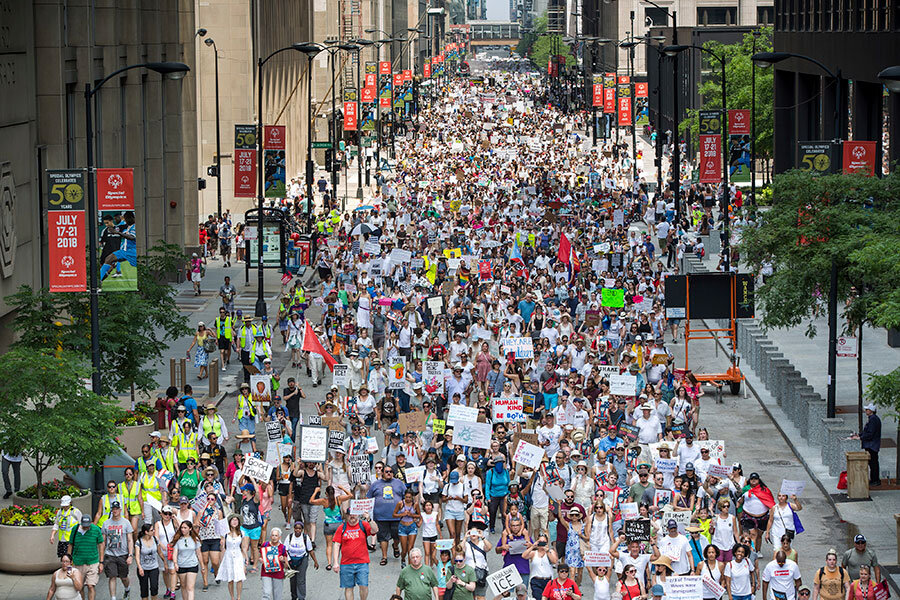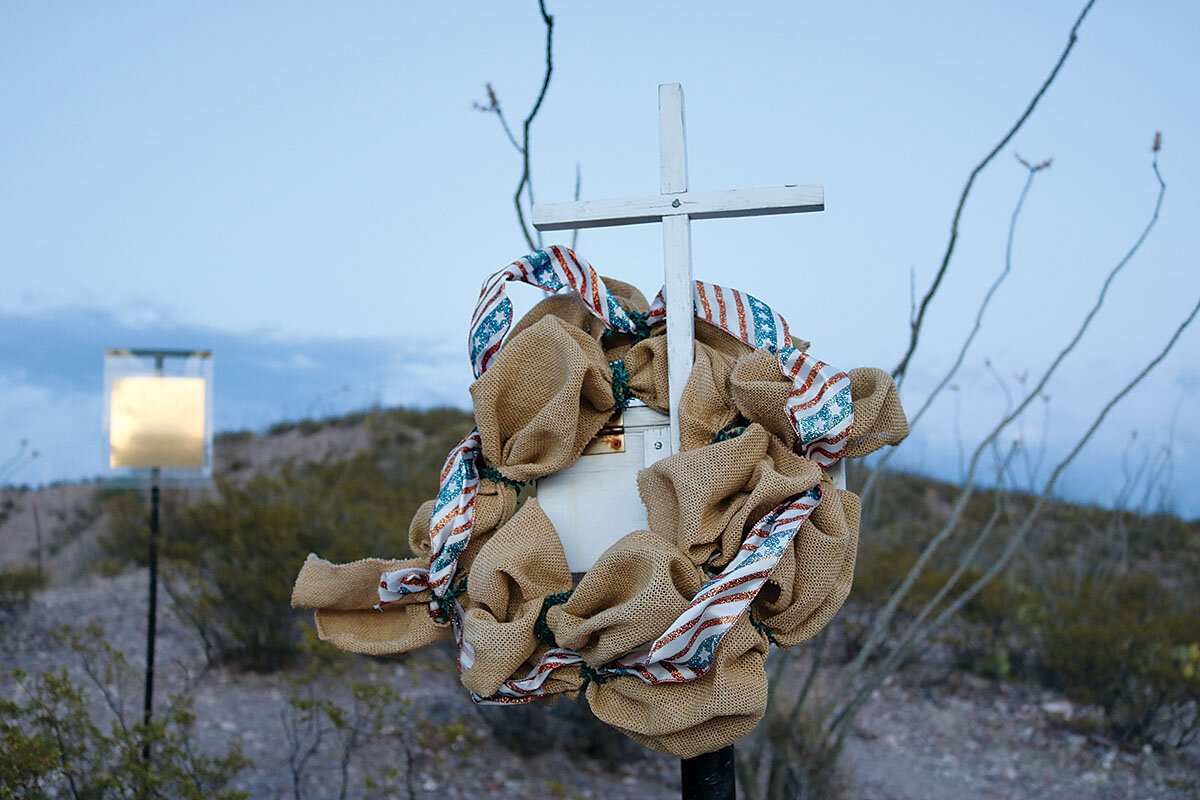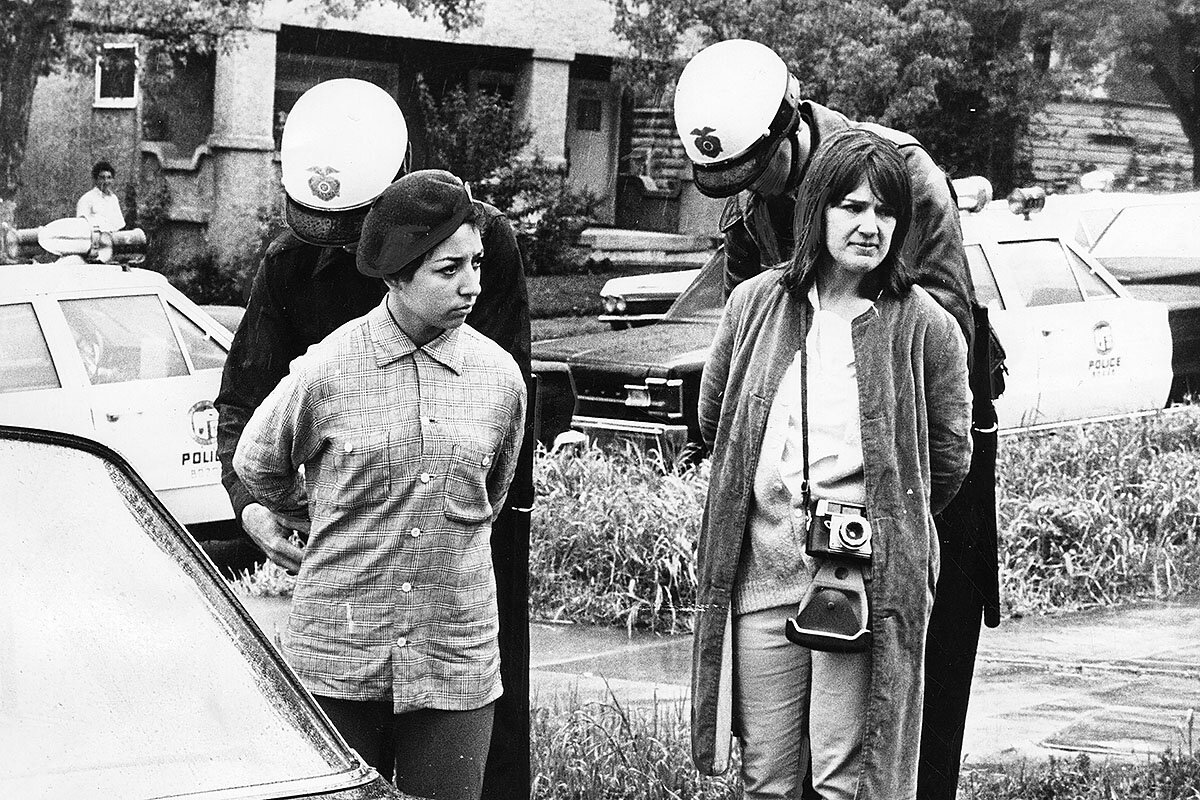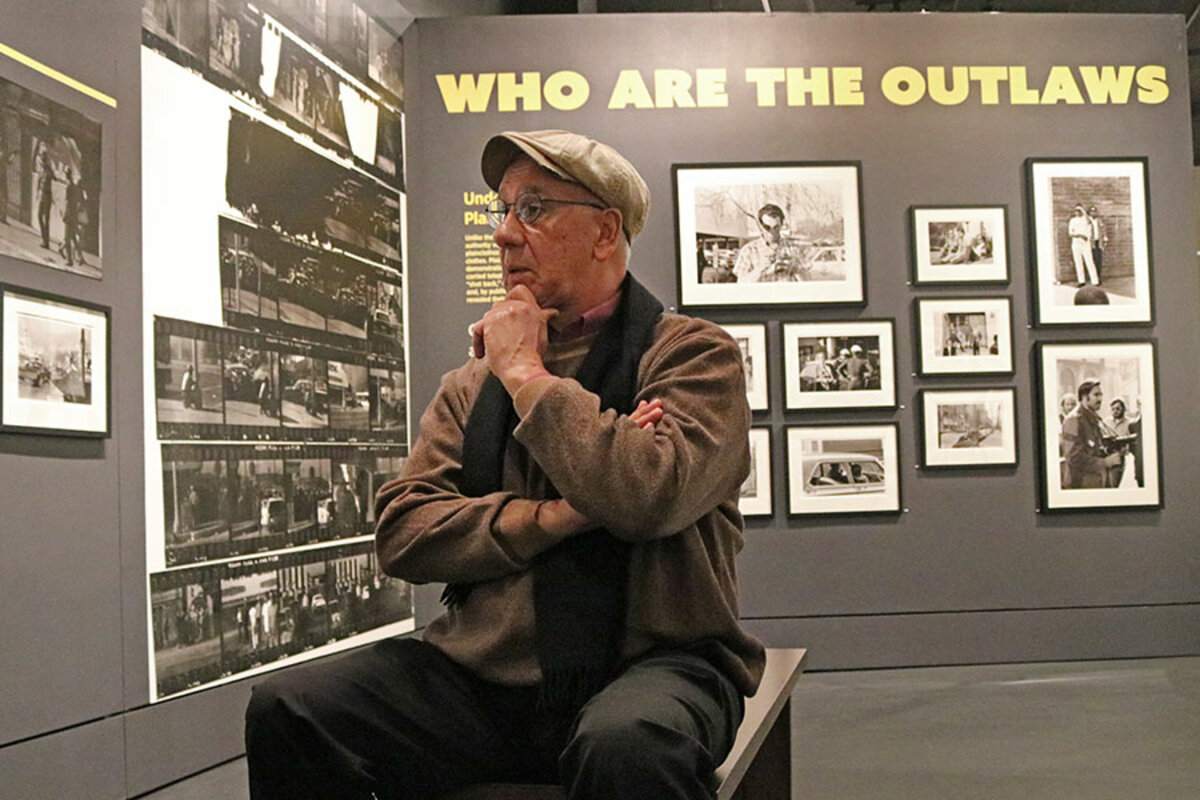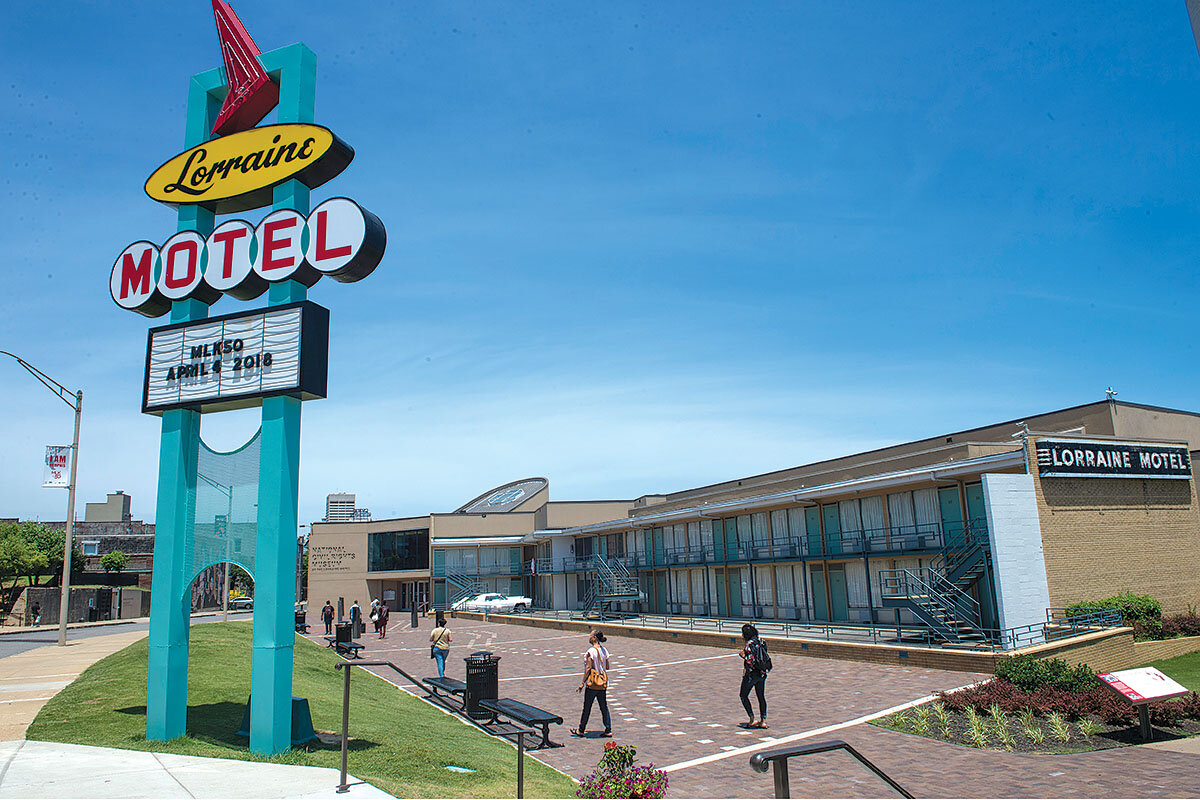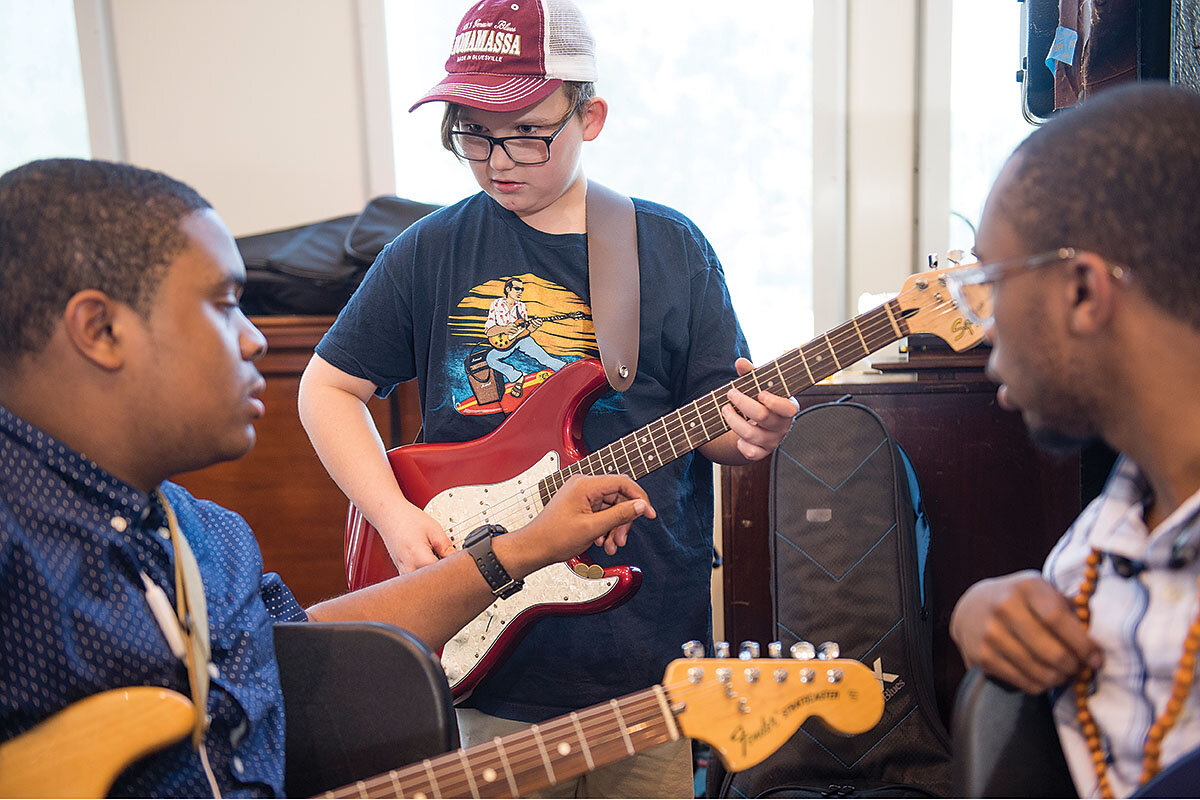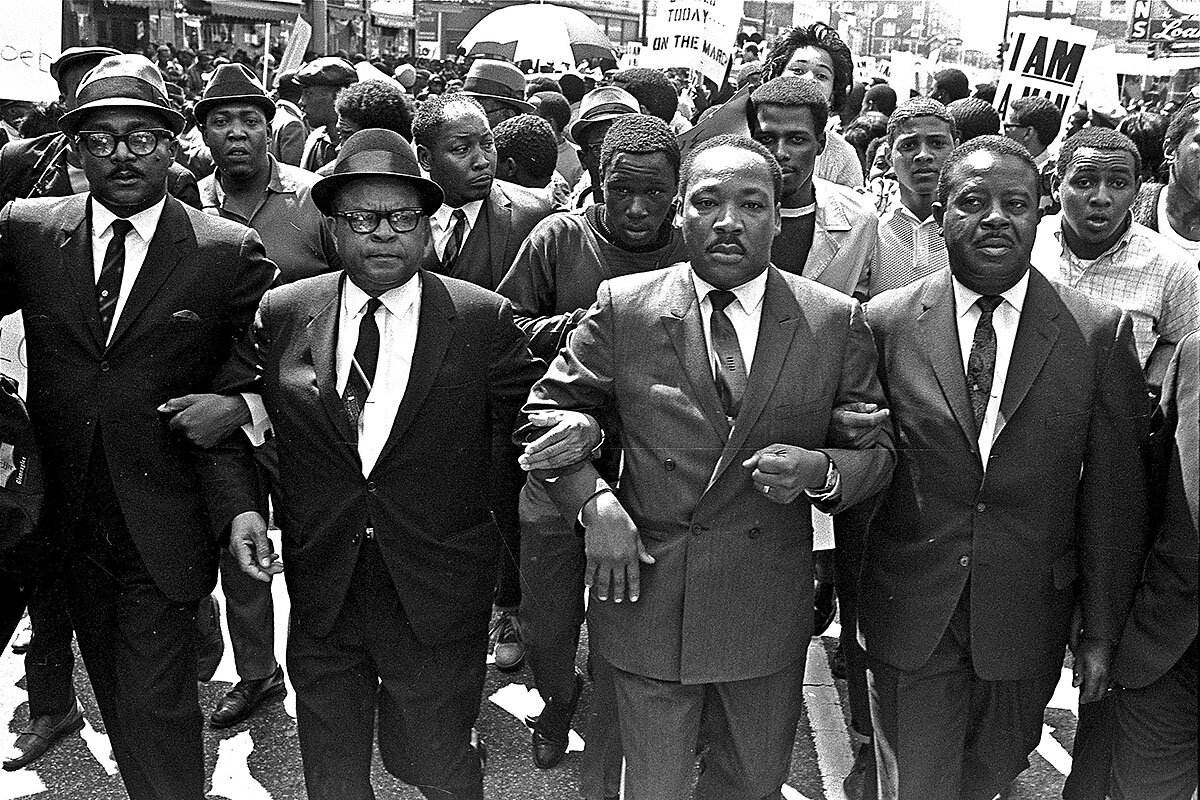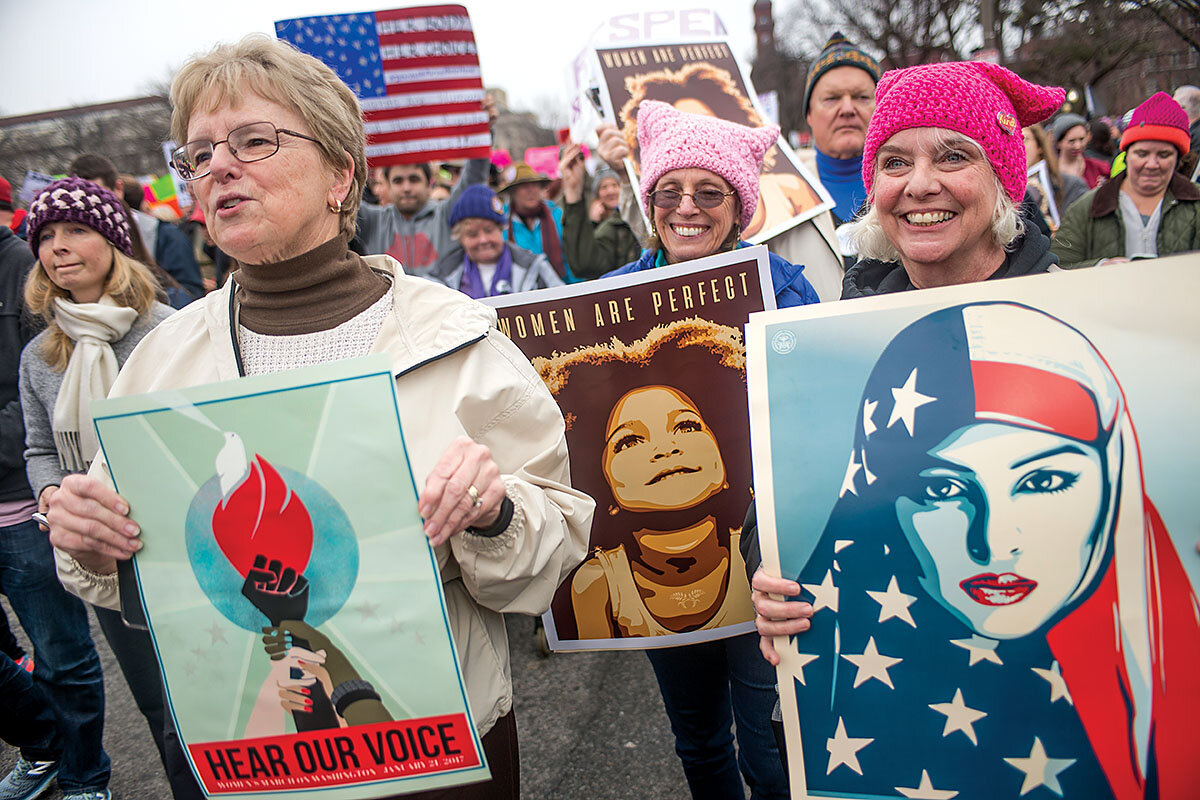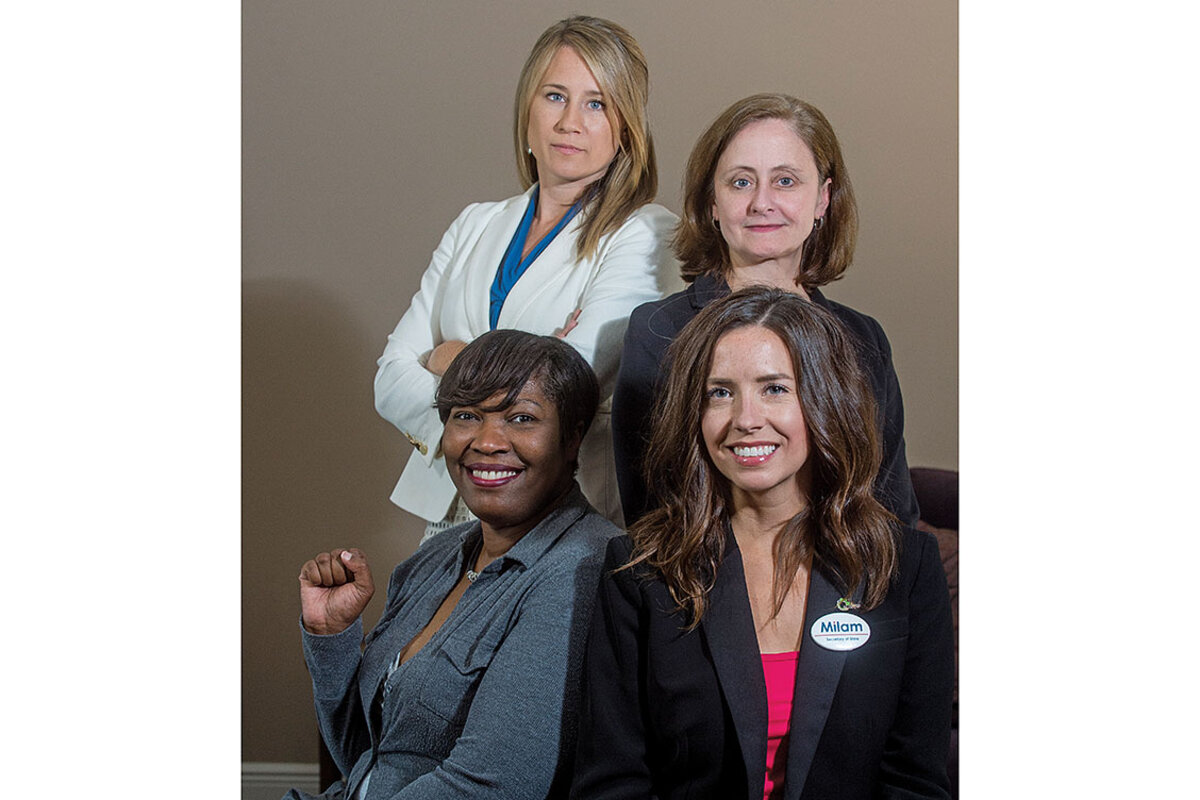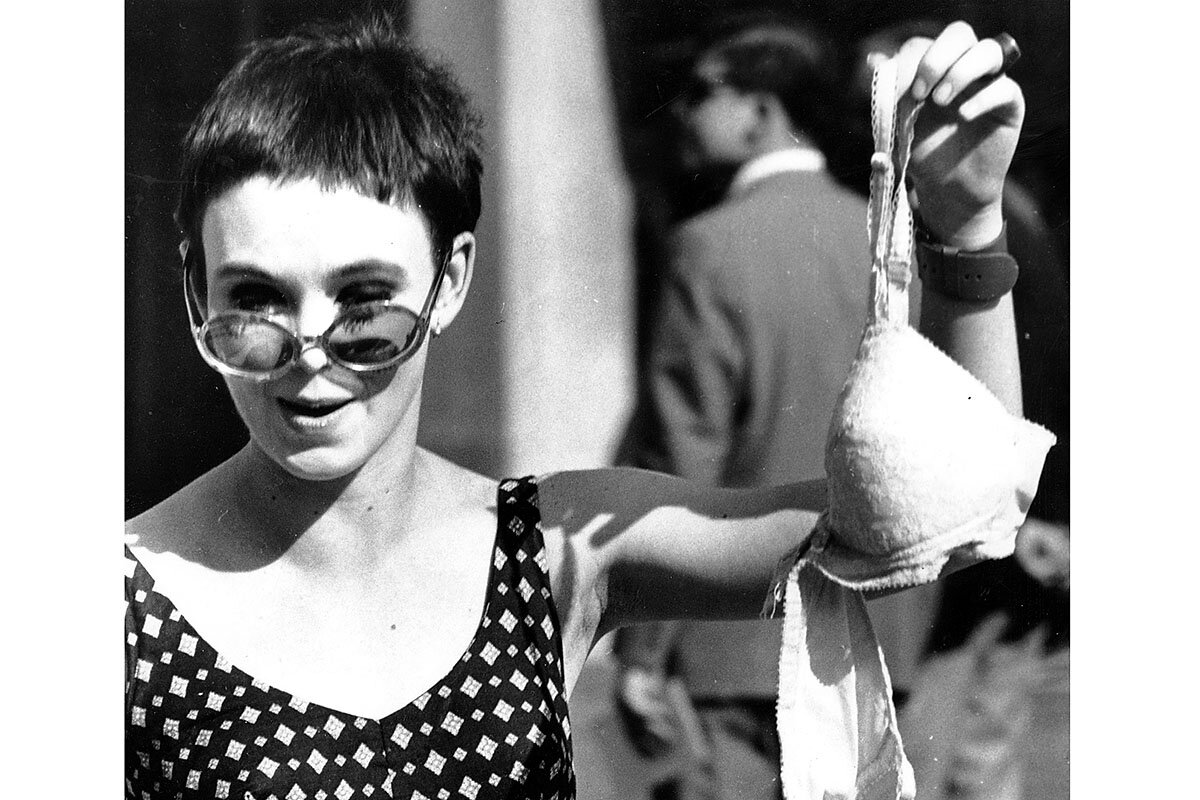From tear gas to tweets: 50 years in the evolution of US activism
Loading...
| On the road from Los Angeles to Washington
The day was dying. We watched it go, the sun streaking the sky pink and orange as it sank behind the red clay mountains that rule the Arizona landscape.
We had just hiked to the top of Mares Bluff here in Clifton, a mining town of 4,500 near the New Mexico border. The steep, rocky path is marked by gold plaques commemorating every conflict involving the United States since World War I. On the cliff’s edge, flags representing each of the branches of the armed forces stand billowing over the town’s buildings and bungalows. The Stars and Stripes towers above them all.
The memorial had been built in 1999 by a group of local veterans, most of whom had served in Vietnam at the height of antiwar fervor. The place is a physical display of advocacy – a silent salute to fellow soldiers by service members who for decades had felt scorned by the country for which they had fought.
Why We Wrote This
In whatever form it takes, activism is the vital manifestation of a genuine belief that change is needed – and a sign that the political conversation is one in which participants are truly vested.
This was our third stop on a cross-country drive from Los Angeles to Washington, D.C. Our quest was to find out how activism has evolved in the past 50 years. Standing on that bluff saluting eras gone by, we could easily feel connected to our trailhead: 1968, an iconic year in US history, one rocked by war and assassinations, by race riots and tear gas, by music, marches, and movements.
Activism had taken center stage that year, shaping American culture, race relations, gender norms, and politics for half a century. We wanted to understand what the period meant to the generation who’d lived during it – and how we, their political and cultural descendants, continue to wrestle with the fallout in 2018.
The trip took 13 days and spanned more than 3,200 miles. Hours of interviews with former and current activists showed us that while the blueprints for battle have changed, the issues many people are fighting for have not. In 1968, the goal was to raise public awareness about the struggle of marginalized communities. Activists then used music, art, and writing as well as protests to bring that struggle forward. In 2018, the dream is not just recognition but representation. Activists today are using the ballot box in a bid to address inequality from positions of power. They also have technology to magnify their impact online, in the streets, and in political discourse.
But today’s progressive movements are still coalescing around race, gender, and inequity – the same issues that undergirded movements 50 years ago. Now, as then, there’s a sense that the system desperately needs a shake-up.
“What drove those movements was a rather wild hope that it was time for the country to repair what had been broken in American history,” says sociologist Todd Gitlin, author of “The Sixties: Years of Hope, Days of Rage.” “It’s the kind of hope that generates commitment ... built on a moral fiber that comes to people as they look out on the world and say: ‘This is the moment we’re going to try something.’ ”
“People today are operating in that same spirit,” he says.
***
We started our trip with a visit to the Autry Museum of the American West in Los Angeles. The museum was staging an exhibition on La Raza, a bilingual magazine published by Chicano, or Mexican-American, activists from 1967 to 1977. The paper had covered the major demonstrations of the Chicano movement, including the East L.A. rallies in the spring of ’68, when thousands of high school students marched to protest poor conditions in predominantly Mexican-American schools. (Three months later, Los Angeles would reel from the assassination of then-presidential candidate Robert Kennedy, who was in California to meet with farmworker advocate Cesar Chavez.)
Luis Garza had been a photographer for La Raza and co-curated the exhibition. As he walked us through the images on display, he told us how the paper’s staff had strived to capture not just protests and riots but also life in “the barrios” of East L.A. “It was about family, it was about children, it was about culture and art,” he says. “It was about representation ... and making an argument for inclusion.”
We noted that minus the beehive hair and muscle cars, La Raza’s photos could have been lifted from the Women’s Marches that followed President Trump’s inauguration in 2017, or the student-led March for Our Lives against gun violence earlier this year. “Nothing has changed,” Mr. Garza agrees, peering at us behind big, round glasses. “That’s the tragedy of it.” Young people today are contending with the same issues. “That’s why this exhibition resonates,” he says.
As we made our way across the country, we would hear echoes of that idea from people who’d lived through the upheavals of the ’60s and those who’ve inherited the outcomes. The era saw major progressive victories: the expansion of voter rights, the abolition of the draft, the beginning of the end of segregation. Yet “none of those issues have really stopped being issues,” says Professor Gitlin, who teaches at the Columbia University School of Journalism in New York City. “The Vietnam War came to an end, but America’s role in the world, and how to conduct race relations, and how to conduct relations between the sexes – those are all in play.”
After our tour with Garza, we struck southeast for Clifton, about 580 miles away. We arrived on a scorching Saturday and took refuge in Steve Guzzo’s blessedly cool kitchen, where he met us with his friend Bob Jackson. Both men had served in Vietnam – Mr. Guzzo from 1966 to 1968 and Mr. Jackson from 1969 to 1970. Guzzo is president of the veteran support group that built the memorial atop the bluff. Jackson helps him manage the site.
Like many Vietnam vets, Guzzo and Jackson are skeptical of activism and its ability to produce positive change. Both men had returned from the service to a country that had turned against the war, and against them. Guzzo recalled the day he landed in Oakland, Calif., in the spring of 1968.
“I come off the plane, and there’s all these protesters protesting the war,” Guzzo says. “This guy spits on me. And he called me a baby killer, drug addict, warmonger.”
That hostility, directed at them first by activists and then the public in general, has made them both wary of marches and movements – even as they applaud their generation’s efforts to make the country a better place. “The ’60s was one of the greatest generations of all time,” Guzzo says as he served up chips and homemade salsa. “All kinds of rights came out of there. We’re talking women’s liberation, gay rights, human rights. It was an explosion.”
But, like Garza, the two veterans are not sure America has improved in the years since. “It peaked, and then it went the other way,” Guzzo says.
***
We left Clifton on a series of state highways that took us north through New Mexico’s Gila National Forest up into Albuquerque. From there it was due east on Interstate 40, through empty stretches of northern Texas and the plains of Oklahoma. Then, suddenly, the land turned lush: Rivers began to widen and trees filled the roadsides. By the time we crossed the Mississippi River into Memphis, Tenn., the desert was a distant memory.
It was in Memphis that we got perhaps our clearest sense of the ties binding activism today and 50 years ago, and what has and hasn’t changed since. On April 4, 1968, Martin Luther King Jr. was shot and killed on the balcony of the Lorraine Motel in downtown Memphis. For a young Al Bell, King’s death was a personal blow. Mr. Bell had marched with the Southern Christian Leadership Conference in Savannah, Ga., as crowds of angry whites spat at and beat them. He’d debated the merits of passive resistance and economic empowerment with the reverend himself, and had even co-written a song for King called “Send Peace and Harmony Home.”
King was trying “to instill in us hope, pride, and belief in a better day, as opposed to hopelessness,” Bell says. “That was very, very important to me.”
The assassination had also come at a time when Bell already had his hands full: He had just taken over as chief executive of Stax Records, a soul music label headquartered on East McLemore Street, just a couple of miles from the Lorraine. Four months earlier, the company’s biggest star, Otis Redding, had died in a plane crash. Stax had also just lost its entire music catalog after a deal with its longtime distributor, Atlantic Records, fell through.
Stax’s survival was important to Bell, not just because he was running the company but because of what it stood for. Stax had maintained a policy of racial integration at a time when Memphis was still deeply segregated. Bell still remembers the first time he walked into a studio and saw black and white musicians writing and recording together. “I’d never seen anything like that before,” he says. “I couldn’t believe that that sound and that feeling and that spirit were coming out of these two black guys and these two white guys. I thought, ‘This is a miracle!’ ”
In 1968, Bell set out to simultaneously release 30 singles and 28 albums in a project he called “Soul Explosion.” The goal was to prove that Stax could still make hit records – and that its black artists, especially, could sell music to mainstream, or white, audiences. The label was also a way to represent “the lives, lifestyles, and living of African-Americans” through music, he says. “That was our activism.”
Today, on the site where Stax once stood, a museum celebrates the label’s legacy. Next door is the Stax Music Academy, which offers after-school and summer programming for at-risk, inner-city youth. The day we arrived, we caught the academy’s summer alumni band warming up. The group plucked songs from the Stax catalog, urging visitors to sing and dance to classics such as “I’ll Take You There” by The Staple Singers.
Later, the academy’s instrumental music director, Paul McKinney, told us that connecting the students with the label’s history is a key part of the program. Their hope is to provide young Memphians with the same kind of opportunity Stax Records did for black artists more than a half-century ago.
“I want them to be armed and educated ... to go out to say, ‘Guess what? I’m good enough. I can do it. I don’t need anybody to give me handouts,’ ” Mr. McKinney says.
“The students are still facing a lot of similar issues, you know, that those Stax artists from the ’50s and ’60s had to deal with.”
***
The movements of the 1960s did move the needle. Laws such as the Civil Rights Act and Voting Rights Act provided real protections that have helped historically marginalized groups begin to find equal footing in American society. In 2018 many people know and accept that they need to speak out and stand against various kinds of discrimination. That was not necessarily true in 1968.
But neither the best-intentioned laws nor the changing tide of public opinion can erase centuries of oppression and disenfranchisement, says Lorena Oropeza, an associate professor of history at the University of California, Davis. Just because a society has decided something is wrong doesn’t mean it’s solved the problem.
“Things have become more complicated,” Professor Oropeza says. “It’s no longer, you’re a black child and you can’t go to a white school. It is the case that you’re a black child or a poor child and you’re in a bad school. It’s much more structural, and that’s harder.”
As the challenges facing activists evolved, so did the technology that helps them organize. Social media now makes it possible to rapidly coordinate massive demonstrations across cities – as it did during the Women’s Marches, the March for Our Lives, and the recent Families Belong Together rallies against the separation of children from their parents at the US-Mexican border. Instant communication allows organizations to flourish without the need for a unifying leader. Smartphones give anyone the power to capture injustice when they see it and upload it to a public forum.
“What took us days, weeks, months, years is now instantaneous,” Garza says. “You have here what makes the difference, the very thing they cannot suppress.” He raises his cellphone. “This is your voice.”
The downside, of course, is that the problems of the internet age apply to activism, too. Misinformation can spread quickly and be difficult to correct, leading to misplaced outrage and sometimes violence. The daily rush of headlines can overwhelm people, creating apathy. And while Twitter can get people donating to a cause or out on the streets, it doesn’t push them to do the grunt work on which real change is founded.
“I see the gathering, and the intention, and the passion people have,” says Gloria Arellanes, a former member of the Brown Berets, a paramilitary group that campaigned for Chicano rights in Los Angeles in the 1960s and ’70s. Ms. Arellanes, who’d joined the Berets at age 19, had spent most of her time with the group running a free clinic that served poor Mexican families in East L.A. She still believes that that was the most important part of her activism.
“[People] will say, ‘I came out, I did what I had to do. Tomorrow I go back to my life,’ ” she says, shaking her head as she sits on her porch in El Monte, Calif. “No. You don’t just march and that makes change. That’s not what makes change.”
***
Still, some of the most successful movements today wouldn’t be where they are without modern technology.
In February, teachers across West Virginia mounted a series of strikes over pay and working conditions in public schools. The state teachers unions, with the support of local school districts and administrators, canceled classes for nine days while educators rallied at the State Capitol in Charleston. In the end, the teachers won all five of their demands – and reclaimed a sense of pride and empowerment after years of being overlooked. Teachers in Arizona and Oklahoma would later follow their lead.
We met Adena Barnette – president of the Jackson County Education Association and one of the most visible figures during the strikes – in an empty classroom at Ripley High School, about 35 miles north of Charleston. With her were music teacher Annie Hancock and English teacher Emily Oakes, both of whom had gone out on strike.
With rain misting the windows, the women told us how crucial technology had been to their effort. All 55 West Virginia counties had closed schools to join the strikes, which wouldn’t have been possible without cellphones or the internet. “I could reach 400 people with this phone instantly,” Ms. Barnette says, waving the device. “We had a text tree set up so I could send a text and it went out to the whole county.”
Facebook and Twitter also kept people connected to the cause. Teachers and their supporters were able to track hearings and recruit new people, even when they were a hundred miles away.
Another shift in activism between 1968 and today is the way groups are trying to induce change. Now they’re as likely to do it at the ballot box as with a placard.
Following the 2016 elections a wave of women and minorities began running for office, many for the first time. The sudden rush toward positions of leadership, especially among women, marks an evolution from ’60s-era feminist strategies of marching in the streets, lobbying for reforms, or tossing bras into the trash.
The idea is that the most relevant way to boost a cause is to do it from within government. “If the current system and the men in charge were going to do things for women and children, they would’ve done it by now,” says Stacie Propst, who in 2017 founded the Alabama arm of Emerge, a national nonprofit that recruits and trains women to run for state and local office under the Democratic banner.
We met Ms. Propst and three other Emerge women, all of whom are on ballots this fall, at Propst’s home in Irondale, just outside Birmingham. “We haven’t done ads,” she says, after installing us at her big, oval dining table. “It’s been networking woman-to-woman, and social media is often the way that women do it.”
Cara McClure, who’s running for a seat on the Alabama Public Service Commission, not only discovered Emerge on Facebook, she also raised the funds for her filing fee – more than $1,900 – through GoFundMe.
Ms. McClure posts regularly on her Facebook page as a way to both campaign and share her experiences with friends and followers. “I write my fears, insecurities,” she says in a soft lilt that belies her tough history. A marketer by training, McClure had lived on the streets, raising her son, before deciding to become an activist and now politician.
She sees social media as an important way of changing the narrative, regardless of her campaign’s outcome. “I’m very mindful that people are watching, and young women are watching,” she says. “So every step of the way I’m thinking about what I’m doing represents.”
***
In many ways, activism in 2018 looks nothing like activism in 1968. We no longer burn draft cards or spit on returning vets. There’s less rioting, more tweeting. Anger flares faster, but it also burns out quicker. Still, as we wound our way east, we sensed an energy in the air, one that called to mind the “wild hope” that Gitlin, the author, had spoken of.
Across the country, we saw people waking up to causes – conservative and liberal – they can support and finding a way to fight for them, just as activists did in 1968. Back then it might have meant wearing a brown beret or a black jacket, taking photos for a magazine, or writing a song with a person whose skin was a different color. Today it would look more like donning a pink hat or waving a rainbow flag or running for office when everyone says you can’t or shouldn’t.
“I’ve become more aware at all levels. I never really felt like I was organizing to make change until this event,” says Ms. Oakes, the English teacher in West Virginia. “We have a platform to build on that I don’t think we had a year ago. And it’s been inspiring to see how we’ve started something.”
“We’re changing the conversation,” adds McClure in Irondale. “I’m just so fired up. Going from homeless single mom to entrepreneur to activist to now politician? The proper, the right type of politician with visionary leadership? Oh my God, chill bumps.”
“I think too many of us were way too complacent because we were comfortable and we felt as if it didn’t matter,” says Heather Milam, who’s running for secretary of State in Alabama. “If we’ve learned anything from history,” she adds, “it’s that we can’t rest on our laurels.”
Back in Clifton, Guzzo and Jackson, neither of whom would consider themselves politically progressive or liberal, have found their own brand of activism. Guzzo regularly maintains the memorial on Mares Bluff, keeping the plaques free of graffiti and the trail clear of debris. Jackson prints dog tags for service members to display on the memorial. The tags hang on wire strung across the flagpoles lining the cliff’s edge. Together the two men helped build another, smaller, memorial park in town for people who can’t make the hike up to the bluff.
Guzzo says helping others – and dedicating himself to a cause he cares about – has been the most effective form of healing he’s found since the war.
“The best therapy for me, and the best therapy I’ve seen for a lot of people, is getting involved,” he says. “The more active you can become, the more self-worth you have.”
Dylan Lewis contributed to this cross-country report, both from behind the wheel and with his notebook.




